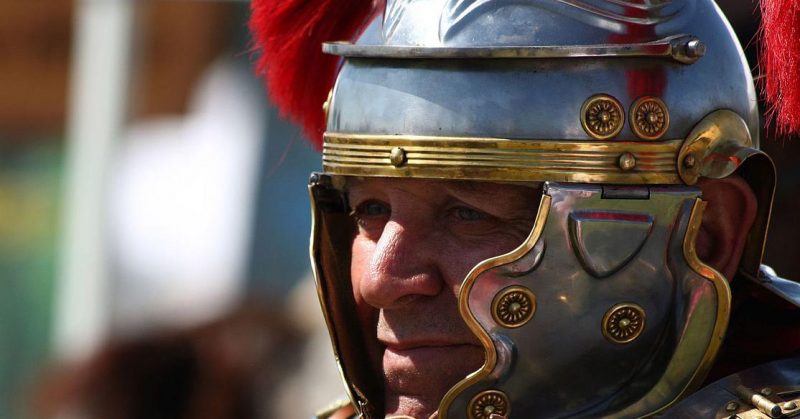The Roman Empire saw one of the first truly professional armies in history, and became the inspiration for European armies that followed it. Though its officers didn’t have the same titles as their modern counterparts, many of the same duties still needed to be fulfilled. There were distinct levels, including equivalents of modern NCOs. Each had their role to play.
Tribunus laticlavius
The senior officers were drawn from Rome’s senatorial class. Though the senate lost most of its political power under the empire, families of senatorial rank were still the elite. Like the nineteenth century aristocracy, they expected senior military positions to go to them.
The tribunus laticlavius was the second-in-command of a legion, the most junior officer role of the senatorial class. It was here that most sons of senators began their military service in their late teens or early twenties. They stayed in this mid-ranking command post for a minimum of a year, with most leaving once that year was up, returning to civilian life. It was common for these officers to be stationed to legions commanded by family members or friends.
Legatus legionis
The legatus legionis commanded a legion, a force of just under 5000 men divided into ten cohorts. He was a senator, usually in his early 30s – a man who had chosen a military career.
Legatus Augusti proparetore
The highest rank an officer could reach was the legatus Augusti proparetore, the military governor of a province of the empire. The careers of most senators combined military and political duties, so they were prepared for such a role, but with so few posts only a minority reached such heights.
The legatus commanded an entire province such as Syria or Britain, and led the army occupying that province. He held the post for an average of three years, but it could be a much longer or shorter period, so some armies lacked consistent leadership.
Praefecti
The next social class down from the senators were the equestrians, roughly equivalent to medieval knights, and they had their own ranks in the military. The usual career path followed three steps – praefecti of an auxiliary infantry cohort, tribunus anticlavius, and then praefecti of a cavalry unit.
Commanding an auxiliary unit did not have the same status as commanding a unit in the legions. Auxiliaries were recruited from the provinces rather than Roman citizens. They were not equipped to the same standards, and were seen as lower quality troops. Service as a praefecti, or prefect, still created opportunities for these officers to advance their careers. They often garrisoned regions with no other Roman forces for miles around and acted independently, giving them freedom to show their initiative.
Tribunus angusticlavii
In between their two praefecti positions, equestrian officers served in the legions as tribune angusticlavii. These were staff officers, and there were five of them in each legion.
Though much of their work involved carrying out the orders of senatorial officers, there were also opportunities for independent command. Detachments of soldiers were often separated off from a legion into a group known as a vexillation, sent to join an army on campaign elsewhere in the empire or to carry out a specific project. Tribuni angusticlavii were sometimes appointed to command vexillations, giving them a chance to lead not just auxiliaries but legionaries.
Praefectus castrorum
The third in command of a legion was the praefectus castrorum, the camp prefect. Unusually for such a senior position, this was usually an experienced soldier who had been in the army for most of his adult life. A former chief centurion, he dealt with much of the administration and with command tasks that required technical knowledge of how the legion worked.
As a result, the legatus legionis was supported by two very different men – one an inexperienced youth from the upper class, looking to forward his career, the other a grizzled veteran of great experience but low social standing.
Centurion
The lowest position an equestrian might hold was also the highest an ordinary soldier could expect to achieve – centurion. These men commanded centuries in the legions or the auxiliary – in the legions, these usually consisted of 80 men. These were the officers who commanded men on a day to day basis, both in war and in camp.
Some men started their careers as centurions, either because they were wealthy or because they were equestrians who could not find a praefecti role. Others were experienced soldiers, usually having served for 15-20 years, who had proved themselves in a more junior position of authority. For an ordinary but hard working citizen soldier, this was the path to wealth, status and even a role in local administration.
Primi ordines
The most senior centurions were the primi ordines, centurions in the first cohort of a legion. Centurions might work their way up to this prestigious role through posts in other centuries.
Pilus prior
The century was the unit men most identified themselves with, but the cohort of six centuries was the basic battlefield unit of a legion. Someone must have commanded the cohort in battle, and though we don’t know for certain, it is likely that this task fell to the pilus prior, the commander of the senior century in the legion.
As these different roles show, the term centurion covered a range of different ranks in today’s terms, rather than being what we would recognise as a single role.
Optio
The optio was a centurion’s second in command, supporting him in organising and commanding 80 men. This was one of three posts collectively known as the principales.
Signifer
The second of the principales was the signifer – the standard bearer. He carried the century’s eagle standard, creating a clear point for men to form up around and follow into battle. This was a prestigious post.
Tesserarius
The third of the principales was the tesserarius, the guard commander for the century.
Source:
Adrian Goldsworthy (2003), The Complete Roman Army.
